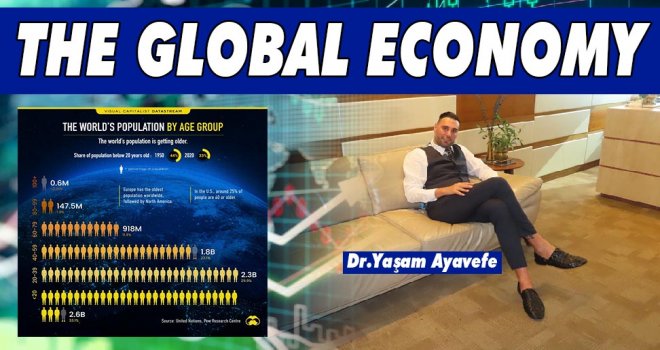

THE GLOBAL ECONOMY
The global economy is a system where interaction between countries of goods, services and economic resources. hence arise the following forms of international economic relations: international trade, movement of capital,labor force migration.

Stages of development of the world economy:
End of the 19th century. The world economy is expressed by socio-economic contradictions; economic development was much lower.
The beginning of the First World War - 50s. social and economic crisis.
50s – 1980s: intensive growth in the export of entrepreneurial capital.
Now: Increasing Economic Interaction and Interdependence countries
International division of labor
The formation of the World market dates back to the beginning of the 20th century.
1) General - division of labor by spheres of production.
2) Private - division of spheres by industry and sub-sectors.
3) Single - specialization of individual countries in the manufacture of individual products.

World population and workforce
Population growth in the world is not the same everywhere. In some countries it accelerated, in others it was reduced.
Population explosion -demographic balance is maintained by high fertility and mortality.
Today, the level of education plays a huge role. In economically developed countries, illiteracy can be said to be eliminated, while in developing countries the rate is still very low.
In the economically developed countries of the world, the number of manual workers is declining. Their place is taken by more educated highly skilled workers. Japan is a country of high culture and literacy.
In Western Europe, the age of people from 15 to 59 years old is 61%, and over 60 years old - 17%. Example USA, Australia, Canada. The share of the child population is 30%. In developing countries, the elderly make up less than 7%. The share of children is from 36% (Asia) to 45% (Africa).
Labor resources - the part of the country's population that has the physical and mental abilities necessary for engaging in socially useful work.
The demographic burden is the ratio between the able-bodied part of the population and the unemployed.
The working week in developed countries is 33–38 hours. Currently, the most significant labor resources are China, India, Brazil, Indonesia. Since the middle of the XX century. in industrialized countries, the transition to a post-industrial society began.
most developing countries have moved from the agrarian to the industrial stage. Hence, the growth of employment in the industrial sector of the economy is increasing. This is a consequence of the rapid growth of the total population in this group of countries. So, China has become the workshop of the world.
Unemployment is a big problem in many countries of the world. high unemployment In the post-socialist countries of Europe.
International labor migration has an economic character: it is the uneven development of countries, differences in the level of wages. Immigrants are more attracted to the USA, Canada, Australia, Western European countries.
Through immigration, host countries solve some of the problems associated with a shortage of workers in those segments of the labor market that are unattractive to the indigenous population: these are transport, utilities, construction, chemical, metallurgical, clothing industries, etc. Many branches of Western European industry and areas services simply cannot function without the involvement of foreigners. Immigrants in France are 70% of those employed in the public utilities sector, in Belgium - 50% of those employed in the mining industry, in Switzerland - 40% of those employed in construction.
By importing qualified specialists, developed countries save on their training and rejuvenate labor resources. Today, some developing countries have also begun to attract foreign workers. These are the oil-exporting countries of the Middle East, the NIS of Southeast Asia and Latin America. For example, in Saudi Arabia, foreigners make up about 40% of oilfield workers, in Kuwait - 58%, in the UAE - 74%.
On the one hand, the departure of surplus workers mitigates the severity of the situation on the labor market, but if we are talking about highly qualified specialists, then the countries of emigration irretrievably lose the funds spent on their training. The "brain drain" has become a threat to national security for a number of countries.
Dr.Yaşam Ayavefe

-
 Bugün yer yer sağanak bekleniyor… Önümüzdeki günlerde sıcaklık 31 dereceye kadar..
Bugün yer yer sağanak bekleniyor… Önümüzdeki günlerde sıcaklık 31 dereceye kadar..
-
 Milletin Partisi’nden YDP’ye İade-i ziyaret!
Milletin Partisi’nden YDP’ye İade-i ziyaret!
-
 Feyzioğlu: KKTC ve Kıbrıs Türklerinin güvenliği, uluslararası hukuka göre Türkiy..
Feyzioğlu: KKTC ve Kıbrıs Türklerinin güvenliği, uluslararası hukuka göre Türkiy..
-
 IMF'den enflasyonla ilgili finansal kırılganlık uyarısı
IMF'den enflasyonla ilgili finansal kırılganlık uyarısı
-
 Dimitriu, Azerbaycan’a KKTC ile parlamentolar arası iş birliği niyeti yüzünden p..
Dimitriu, Azerbaycan’a KKTC ile parlamentolar arası iş birliği niyeti yüzünden p..
-
 Ege Denizi'nde 4,5 büyüklüğünde deprem
Ege Denizi'nde 4,5 büyüklüğünde deprem
-
 340 adet küçükbaş hayvan dağıtımı yapılacak
340 adet küçükbaş hayvan dağıtımı yapılacak












